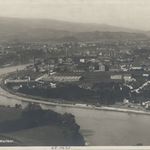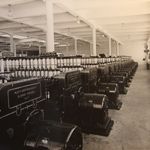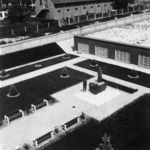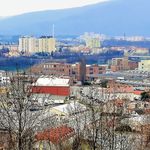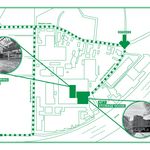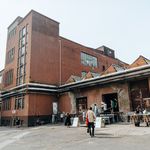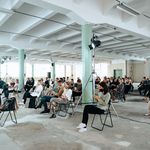EKO 8 / Location

EKO 8 / Location
Former MTT factory in Melje
Ulica heroja Šaranoviča (no number)
Maribor / Melje
The EKO Triennial is leaving the gallery space and entering the urban fabric with the aim of reactivating neglected urban spaces that show creative potential. The first location of the renovated triennial is the area of the former Hutter factory or MTT factory in Melje. With an area of 44,000 m2, a location along the Drava embankment, close proximity to the city center and recognizable modernist architecture, it represents an important urban environment. This sleeping giant in Melje will be the venue for the EKO 8 Triennial, and future editions will look for new spaces and new challenges for the city."The EKO 8 Triennial will take place in several rooms of this fascinating factory, and with the program of the triennial we also enter the wider area of degraded Melje and with creative events open discourse about new possible contents of this forgotten part of town." (Simona Vidmar)The former Hutter factory or MTT factory in Melje stopped all machines in 2014 and was put on the market, but in the minds of the city, MTT remains synonymous with industrial Maribor and the city of great victories and defeats. What the story of the creation and development of this iconic factory hides is revealed in a short historical outline prepared by the historian Boris Hajdinjak.
Historical Outline of the Former HUTTER / MTT Factory
Josip Hutter (1889, Dolnja Briga − 1963, Innsbruck), a descendant of German settlers in Kočevje, is a synonym for the thriving city of Maribor and its flourishing textile industry before World War II (→ Photo 1). The memory of him lives on in the factory in Melje (a district of Maribor), the settlement of single-storey houses in Pobrežje district, and the Hutter block of flats in the city centre. Crucial for preserving Hutter's reputation to this day is the Hutter factory in Melje with its present address at Kraljeviča Marka Street 19. The Hutter factory was, however, not the first textile factory in Maribor. This was a factory established in 1922 by two Czech Jews, Eduard Doctor (1857, Náchod − 1926, Vienna) and his son-in-law Dr Ernst Zucker (1880, Strakonice − 1958, Montevideo), located in the Studenci district. In the year when the operation of the first Maribor textile factory commenced (1922), Hutter moved from Ljubljana to Maribor as a merchant.
Hutter founded his factory and began its construction in 1926. The factory's official name was J. Hutter in drug (J. Hutter and Partner), as the co-owners were also Hutter's wife Elizabeta, née Hribar (1899, Izlake − 1994, unkn.), and the spouses Richard and Theresia Poche from Austria. The Hutter factory was also not the first textile factory in the Melje district, this was instead a factory established in 1923 along the then Motherjeva Street (today preserved only as part of the Heroja Šaranovića Street) by two immigrant Jews, Bedřich Schonsky and Viljem Löbel − surname changed to Larič in 1938 (1892, Stupava − 1966, Vienna), which was in 1925 renamed to Mariborska tekstilna tvornica (Maribor Textile Factory). The Hutter factory was built right next to it.
Initially, the Hutter factory employed about 360 workers in one production hall (→ Photo 2). Hutter’s management of the company was so successful, because it relied not only on his business acumen, but also on the well-paid workers. Over the years, both the number of employees and the number of buildings in the factory increased. By 1939, the number of employees had grown to around 1,500, representing a fifth of the overall 7,452 employees in the Maribor textile industry, the largest centre of this industry in Yugoslavia. The first building that followed the original factory hall − for the production of trousering fabrics − was a quilt mill built in 1929. Between 1932 and 1940, a new building was erected every year. By 1940, the factory buildings expanded along both sides of a 330 metre long section of the former Motherjeva Street (→ Photo 3). The area of the factory buildings was equivalent to the size of almost five football pitches. The largest were the spinning mill, built in 1933 and further enlarged in 1936, the thread facility and the new hall for the production of trousering fabrics set up in 1936, and the silk mill erected in 1939. Some of the older buildings, among them the first factory hall from 1926, were demolished due to new spatial demands. Since its construction in 1934/35, the most notable and the tallest building in the city was the 70 metre high chimney (→ Photo 4). If it were still standing, it would remain the tallest until today.
Not only did the dimensions of the Hutter factory caught the eye, but also the quality of its buildings. It is possible that some of the buildings were designed by the then most modern Maribor architects Aleksander Dev (1903, Lukovica − 1967, Maribor) and Jaroslav Černigoj (1905, Bovec − 1989, Maribor). Both are better known as the architects of the Hutter block in the centre of Maribor. Most of the construction work was carried out by the company of Rudolf Kiffmann (1869, unkn. − 1940, Graz), the largest company of its kind in the city. In 1936/37, the same company also built the Hutter colony in the Pobrežje district for the Hutter factory employees. The quality of the factory buildings is manifest not only in their external appearance (→ Photo 5), but also in the interior, which exudes order, tidiness, and the optimal use of space (→ Photo 6). And that is not all: tidiness and a pleasant working environment were also reflected in the green areas surrounding the buildings, which were so numerous that a separate employee was required to take care of them. The statue of the Spinner − the work of the then most famous Maribor sculptor Ivan Sojč (1879, Ljubnica − 1951, Maribor) − stood on the lawn at the entrance to the factory since 1937 (→ Photo 7). The fact that the Spinner wears a Slovenian national costume shows Hutter's respect for the predominant nation in the environment in which he lived and made his fortunes. All of these characteristics are undoubtedly a reflection of Hutter’s commitment to making his workers feel as comfortable as possible in their workplace.
Unlike some other factories in Maribor, the Hutter factory did not suffer severe damage during World War II. Yet, the fact that the factory worked for the German occupying forces during the war was used by the new authorities for a rigged trial against Hutter immediately in its aftermath. In doing so, they divested him of his property and freedom, and later on, with his departure abroad, also deprived him of the place where he spent the most beautiful years of his life. Nonetheless, the post-war authorities could never take away from him the reputation he had amongst his former workers and fellow citizens. The construction of the first research institution in the city, the building of the Maribor Textile Institute, which was founded in 1947 on the premises of the former Hutter factory (→ Photo 8), further affirmed his reputation. It is certainly no coincidence that the Hutter factory became the headquarters of the newly established state-owned company Mariborska tekstilna tovarna (abbr. MTT, Maribor Textile Factory), which in 1947 merged all textile factories in Melje and was by 1963, the year of Josip Hutter’s death, joined by most of the other textile factories from Maribor. In 1982, the company had 5,070 employees, despite the fact that its development did not always run smoothly. With the break-up of Yugoslavia, the agony began, which led to the complete abandonment of textile production on the premises of the Hutter factory since 2014 (→ Photo 9). The memory of the former activity and related developments should be preserved at least in one part of the factory. Hutter himself and his workers certainly deserve it. (Boris Hajdinjak, historian and director of the Maribor Synagogue)
Boris Hajdinjak's research interests include the medieval and early modern history of Slovenia, the history of Maribor in the first half of the 20th century, and the history of the Holocaust in Slovenia and the countries of the former Yugoslavia. He has participated in museum exhibition projects in Brežice, Maribor, Ljubljana, Ptuj, and Ravne na Koroškem.
photo 1: Josip Hutter during his residence in Maribor (courtesy of Josip Hutter Jr).
photo 2: View of the Melje district from the Meljski Hrib hill, postcard sent in 1930 (courtesy of the Maribor Regional Archives). In the left central part, three chimneys can be seen along the Motherjeva Street: the nearest stands next to the Maribor Textile Factory erected in 1923; the chimney to the left stands next to the first production hall of the Hutter factory from 1926; and the chimney to the right is located next to the second production hall of the same factory from 1929.
photo 3: View of the Melje district from the Meljski Hrib hill, postcard sent in 1939 (courtesy of the Maribor Regional Archives). In the centre of the photo, next to the chimney in the foreground, is the Maribor Textile Factory. Around the much higher, 70 m chimney, stand the buildings of the considerably expanded Hutter factory. The first production hall still stands, now without the chimney. The second hall, also without the chimney, is surrounded by two new halls erected in 1932, 1934, and 1936. Next to the chimney is the boiler plant, erected in 1934/35 and enlarged in 1937, as well as the power plant built in 1936. The new hall for the production of trousering fabrics from 1936 extends towards the Drava River. The large two-storey building to the right of the chimney is the spinning mill, built in 1933 and enlarged in 1936.
photo 4: View of the Hutter factory from the Pobrežje district across the Drava River towards the city centre, photo from 1938 (photographer: Franjo Pivka, courtesy of the Maribor Regional Archives). Particularly prominent is the 70 m high chimney, which was the tallest building in the city since its construction in 1934/35. If it were still standing, it would remain the tallest until today.
photo 5: The interior of the Hutter factory complex, photo taken after 1936 (courtesy of Josip Hutter Jr). To the left is the production hall, to the right the spinning mill, in the background the boiler plant with the 70 m tall chimney and the power plant. Between the buildings is the green area with a fountain.
photo 6: Production hall with spinning machines for stretching, doubling, and twisting yarn in the spinning mill of the Hutter factory, photo probably taken in 1934 (photographer: Vladimir Vlašič, published in: Mariborske slike. Ob priliki III. Mariborskega tedna [Pictures of Maribor. On the Occasion of the 3rd Maribor Week], Maribor, 1934, p. 91). The machines were manufactured by Platt Brothers from Oldham, England, in 1933, the same year as the spinning mill building was erected. Founded in 1770, the Platt Brothers company became the largest manufacturer of textile machinery in the world in the early 20th century. At the time when the machines were being set up in Maribor, the economic crisis prompted the company to merge British textile machine manufacturers into the Textile Machinery Makers cartel. The decline of the British textile industry also affected Platt Brothers, which after more than two centuries ceased their operations in 1982.
photo 7: The interior of the Hutter factory complex, photo taken after 1937 (courtesy of Josip Hutter Jr). In the centre stands the monument of the spinner in Slovenian national costume, created by Ivan Sojč in 1937. The pedestal originally said "Honour and Power to Work!", but was changed after 1945 to "Honour to Work!". To the right of the statue is the thread facility built in 1936. Seen above are a part of the Kraljeviča Marka Street and the military barracks in Melje.
photo 8: Panorama of the Melje district with the Meljski Hrib hill and Malečnik in the background, photo from 1961 (photographer: Jože Gal, courtesy of Večer newspaper). The Maribor Foundry is in the front, the Hutter factory as the headquarters of MTT in the back. In the centre is the boiler plant with the 70 m tall chimney. In the back are two multi-storey buildings constructed in 1940. To the left of the main entrance is the spinning mill, to the right are the administrative building, erected in 1939 and expanded after 1945, and the premises of the Maribor Textile Institute built in 1949.
photo 9: View of the Hutter factory or MTT from the Northeast, photo from 2016 (photographer: Domen Kodrič). In the central part is the boiler plant. The 70 m high chimney was removed in 1992.

